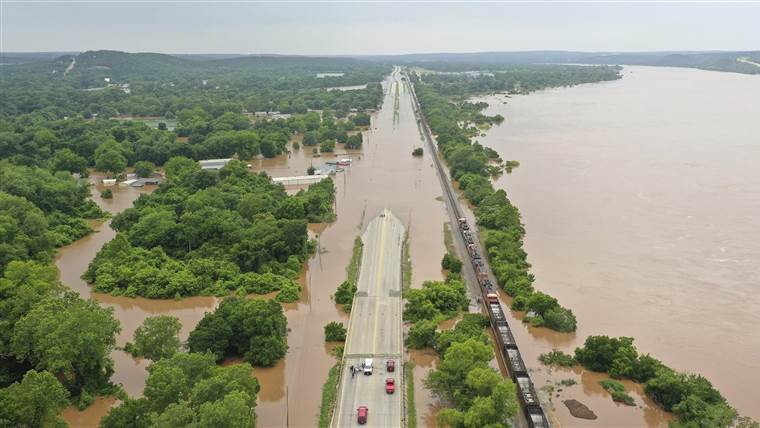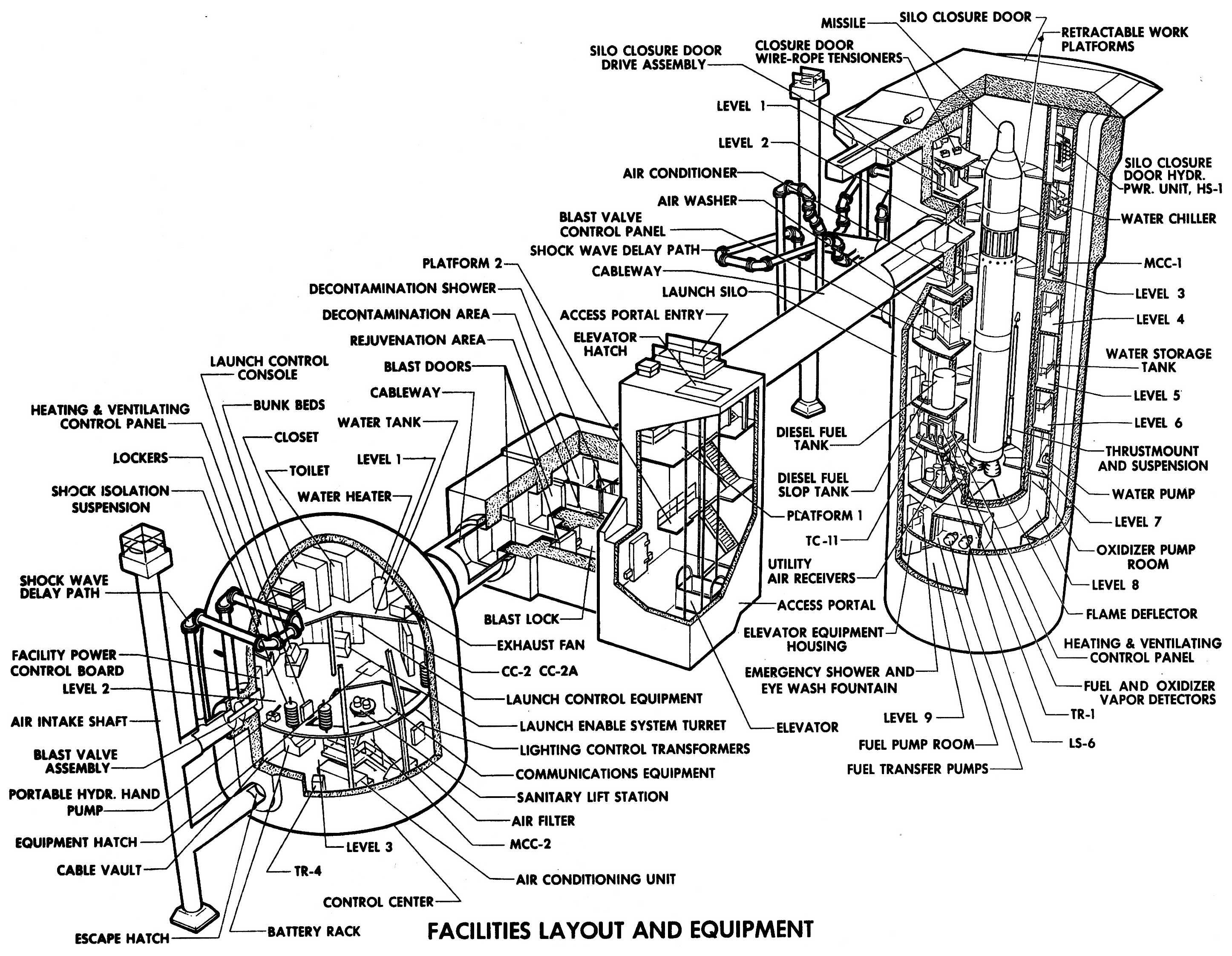When there are flood waters, it’s easy to forget how completely everything gets damaged. There’s the obvious stuff, like rivers of pig shit and urine going into the rivers and then everyone’s living room, but what about the subtle stuff – the stuff most of us won’t even think of?

God’s revenge on Arkansas for not passing a red flag bill
I stumbled on this one the other day – and, as the genuine owner of a decomissioned property from the 1950s, I feel a great deal of familiar pain. But when I start to think about what these folks are dealing with, my mind just goes blank. A few times the fellow references “the former owner” – my bet is that individual signed the deed and walked away as fast as his two feet could carry him. Let’s talk about a money pit:
Imagine you owned a Titan-II missile base, and it flooded.
That ought to be enough right there, right? Run screaming from the room. First off, when your postings are like: “we were able to pump the water level down to the point where you can walk around on Level 1” it sucks if you know those places have 3 levels. I’m spoilering a bit here so if you want to, you can watch the video then come back. The part where he’s talking about the bulkhead separating the hallway from the launch tube – that’s the material of existential dread for me: there is 100,000+ gal of water on the other side of that door. That’s just the water difference between the opening of the silo and the access tunnel, which is 3 stories down. There’s another 6 stories of water, from there.

I’d immediately disqualify that place as a home. Imagine if the levees up-river break and you’re in your bedroom (down in the round-roofed hut lower left) and a rill of water runs across the floor? I’d be up, on my feet, screaming “LET ME OUTTA HERE!” in a second.
My rule regarding flooding is very different from my rule regarding lightning: lightning seldom hits the same way/place twice unless it’s a lightning rod so don’t get near those, but something that has flooded once will always flood again, usually when you are not around to manage it.
Ground-launched nuclear missiles turn out to be a really bad idea. Unless you situate them amazingly carefully. Mobile platforms like submarines are better; the only trick there being able to re-surface them on command, and to not cook off a missile in the launch-tube. Remember: our political leaders tell us we need these things to defend us against others like them. It seems to me to be a bad idea all around.
I hear that the Augean Stables are for sale, discreetly, to buyers of distinction with deep pockets. If you are interested, bury $10,000 in your back yard; one of our underground agents will contact you.*

Coincidentally, I just finished playing through Fallout New Vegas and I was thinking “they did a pretty good job with extrapolating what all the rust and schmutz of these underground silos would be like…” and Youtube went and served one right up for me.
What a shithole.
* extra credit to any member of The Commentariat(tm) who recognizes where that came from.

Not sure if that’s where it comes from, but I remember a line like that in Illuminatus!
What got to me was how matter-of-factly optimistic and cheerful he sounded. Huh?
@LykeX:
Well done!
Back in the Soviet times the state confiscated all the land and used the good one for kolkhozs. Of course, there was also the leftover land that nobody wanted—places that flooded, were poorly located, etc. Poor people from cities would use such land for small gardens, these gardens were usually about 600 m2 large. As time went by, some of these people who were cultivating these little gardens also built homes on this land. This is why nowadays in Latvia you have entire neighborhoods that flood every spring. The sensible thing to do would be to abandon these settlements, but people who live there cannot afford to move somewhere else, so they routinely demand the government to invest more and more money into building roads in these places, creating additional infrastructure that would ameliorate flooding and so on.
That’s the sunk cost fallacy at work—people have already invested money into building homes in places where nobody should be living in the first place, so they are reluctant to just abandon these homes. The other problem is that the government is expected to manage the flooding of rivers every spring, the government is also expected to build infrastructure like roads, electricity lines, etc. The government isn’t expected to just give people money so that they can move away from some shitty land that is located in a remote place and floods and where homes shouldn’t even exist to begin with.
Hercules, but I’d need to look up the river he diverted to clean the years worth of shit.
Why would anyone put a nuclear silo in a place that floods? Why would anyone buy such a place? It needs too many hours worth of money and work to make it fit for occupation and I’d never get past worrying if that bulkhead with the leak would hold. I sure couldn’t sleep in the place.
Keeping water out of a submarine is arguably more difficult and necessary than keeping water out of a buried missile silo. Both require maintenance. The difference is that the submarine doesn’t give you much chance to fart around half-assing it.
ahcuah@#2:
What got to me was how matter-of-factly optimistic and cheerful he sounded. Huh?
I know, right?
“We’ll just hit it with a pressure washer then spend 20 years applying 15,000 gallons of Rust-Oleum.”
I loved the “we have a little bit of asbestos and our guy will remove it.” If I recall correctly the fuels those things flew on was carcinogenic, teratogenic, and sarcastic – missile conmand only blew up two siloes due to leaks, I’m sure the air down there is just “great”. You have to picture Trump saying that: “it is the best air ever.”
Don’t forget, the same hurricane flooded half the air force’s remaining supply of F-22s. “Colonel, the cockpit smells like chicken shit.” “Shut up and fly.”
Some of the first in ground silos built in the US are up in the Adirondacks and around the edges of Lake Champlain. These were the silos for the Atlas missiles built during the early 60’s, they were already obsolete by the time they were built and were retired after only about 2 years in service.
There were 12 build around Plattsburgh AFB NY, mostly up in the mountains but several close to the lake and some very close (spitting distance) to the border with Canada. From what I’ve heard from locals is that some of the sites near the lake were flooding even before construction completed.
Take a look at the location of the first four sites listed in the Wikipedia article at: https://en.wikipedia.org/wiki/556th_Strategic_Missile_Squadron and see if you can figure out the logic of the military planner who decided to put silos so close to one of the largest and deepest lakes in the US.
There is also a good writeup in Vermont Seven Days: https://www.sevendaysvt.com/vermont/bombs-away/Content?oid=2135204 on the state of each silo as of 2006.
Oh and they didn’t use Rust-Oleum ;-)
https://www.wd40.com/history/
I was more than a bit freaked out when he was talking about how much water there was on the other side of the bulkhead and saying it had just bowed a bit, but it had held for two year so he wasn’t worried … dude it held when there was equal and opposite pressure frome the water you have just pumped out. Water in quantity is such powerful stuff, it scares me, don’t mess with it, you will lose.
Fuck Illuminatus takes me back, reading a brother’s copy some time in the late seventies while staying with him in London, spending my time exploring London and his booksehelves.
@Andreas Avester, Marcus:
There’s a reason why, after Hurricane Hazel hit Toronto back in 1954, the city told developers that hell no, they weren’t going to be rebuilding in the flooded Humber River valley; the city expropriated the land and turned it into parkland instead. Not that the expropriation was uncontroversial. (Much of the parkland is in fact deliberately dug down below the rest of the ground level, so that if the Humber floods again, the parks will absorb the overflow.)
@9
Well, if it floods you’ve got a nice convenient place to pump the water out into. Plus, on the days when you’re not actively plotting the extermination of all mankind, the water-skiing is great!
Honestly, it you dig a hole pretty much anywhere it tends to fill up with water. There’s a whole wad of engineering that’s been developed to exclude water from holes, and to get water out of holes. It’s a thing you manage, rather than avoid, because avoiding it means you’re putting your holes into a pretty limited set of places in the world.
That looks very much like a static, underground submarine to me.
Where are they pumping all that water to? Or maybe my question is, did all that water come in over the top or was/is it seeping in from the ground water?
Woah, the post-apocalyptic-LARPer/abandon place explorer in me really wants to visit this.
Also yes: What were they thinking putting it there?
Personally, to me this looks like a phenomenal monument to wasted money. Isn’t it great what sort of crap gets infinite money thrown at it for all the wrong reasons? Not just building the bunker, but maintaining it, staffing it for however long it (and its many counterparts) were in service. And installing the doomsday device – finicky at best – and maintaining that so it would be good to go at any time. Add to that a hefty security and safety bill because, well, finicky doomsday device.
And all it “gets” you is a single shot at destroying a single “enemy” city. And that was worth it, apparently. All of it. All the money, all the waste, all the death along the way. Great job! Next time the US government does its song and dance about budget, maybe someone could point out this rusty boondoggle and tell them to go home and leave the budget to competent people with some foresight.
P.S.: My eyes widened a bit as well when the proud silo-owner announced the likely watermasses behind that “slightly bowed” bulkhead. A fine example of tempting fate.